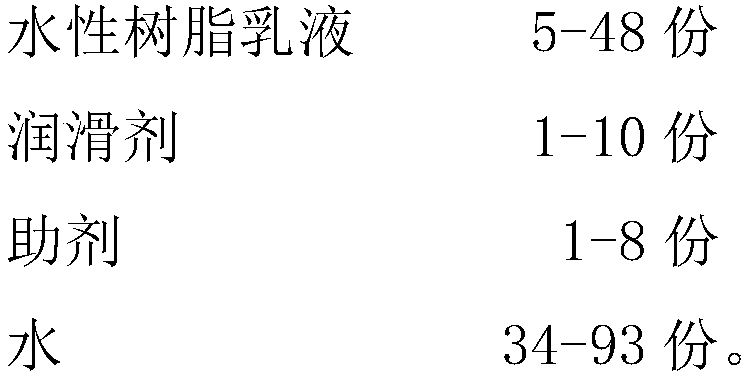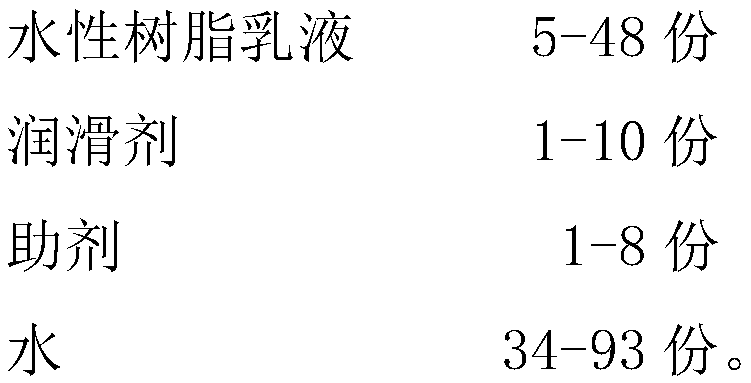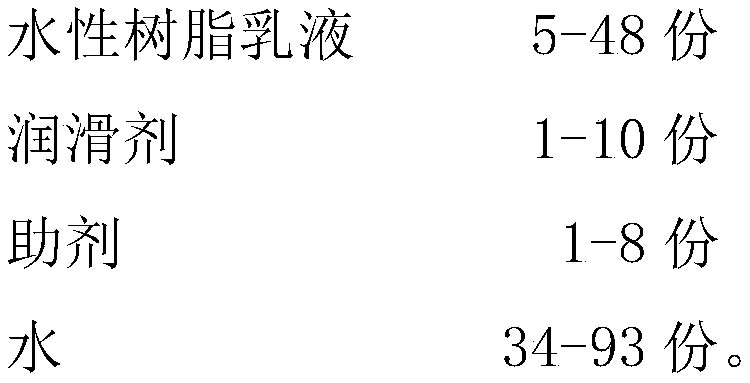Water-soluble back coating solution for thermal transfer ribbons and preparation method thereof
A thermal transfer printing, water-soluble technology, applied in coatings, polyurea/polyurethane coatings, etc., can solve the problems of failing to meet environmental protection requirements and high energy consumption, and achieve energy saving, low energy consumption, and cost reduction.
- Summary
- Abstract
- Description
- Claims
- Application Information
AI Technical Summary
Problems solved by technology
Method used
Image
Examples
Embodiment 1
[0024] Acrylic emulsion 5g
[0025] Emulsified silicone oil 2 grams
[0026] Leveling agent 2 grams
[0027] water 91
[0028] Weigh 91 grams of water and add it to the mixing tank, then weigh 5 grams of acrylic emulsion (solid content 60%), slowly add water while stirring, stir evenly and completely dissolve, weigh 2 grams of emulsified silicone oil and 2 grams of leveling agent Add to a mixing tank and mix well. The whole process is carried out at room temperature.
[0029] The back coating solution is applied to thermal transfer printing and thermal sublimation carbon ribbons at 0.05-0.2 grams per square meter to meet the requirements of carbon ribbons for back coating. Heat resistance instantaneous temperature 260 degrees. Friction coefficient Kd<0.2. It is no problem to continuously print 30 rolls of 110X300m carbon ribbon with a Zebra 300dpi barcode printer at 14 degrees. No powder drop, no pollution to the print head.
Embodiment 2
[0031] Polyurethane emulsion 12g
[0032] Dispersant 2 grams
[0033] Emulsified silicone oil 2 grams
[0034] water 84 grams
[0035] In the production process, weigh 84 grams of water and add it to the mixing tank, then weigh 12 grams of polyurethane emulsion (solid content 30%) and slowly add it to the aqueous solution while stirring. After stirring evenly and completely dissolving, weigh 2 grams of emulsified silicone oil and 2 grams of Add the dispersant to the mixing tank and stir evenly. The whole process is carried out at room temperature.
[0036] The back coating solution is applied to thermal transfer printing and thermal sublimation carbon ribbons at 0.05-0.2 grams per square meter to meet the requirements of carbon ribbons for back coating. Heat resistance instantaneous temperature 260 degrees. Friction coefficient Kd<0.2. It is no problem to continuously print 30 rolls of 110X300m carbon ribbon with a Zebra 300dpi barcode printer at 14 degrees. No powder d...
Embodiment 3
[0038] Nitrocellulose Emulsion 6g
[0039] Polyurethane emulsion 8
[0040] Emulsified silicone oil 2 grams
[0041] Antistatic agent 3 grams
[0042] 81 grams of water
[0043] In the production process, weigh 81 grams of water and add it to the mixing tank, then weigh 6 grams of nitrocellulose emulsion (solid content 25%) and 8 grams of polyurethane emulsion (solid content 25%) and slowly add it to the aqueous solution while stirring, stirring evenly and completely After dissolving, weigh 2 grams of emulsified silicone oil and 3 grams of antistatic agent, add them into the mixing tank and stir evenly. The whole process is carried out at room temperature.
[0044] The back coating solution is applied to thermal transfer printing and thermal sublimation carbon ribbons at 0.05-0.2 grams per square meter to meet the requirements of carbon ribbons for back coating. Heat resistance instantaneous temperature 260 degrees. Friction coefficient Kd<0.2. It is no problem to conti...
PUM
| Property | Measurement | Unit |
|---|---|---|
| solid content | aaaaa | aaaaa |
Abstract
Description
Claims
Application Information
 Login to View More
Login to View More - R&D
- Intellectual Property
- Life Sciences
- Materials
- Tech Scout
- Unparalleled Data Quality
- Higher Quality Content
- 60% Fewer Hallucinations
Browse by: Latest US Patents, China's latest patents, Technical Efficacy Thesaurus, Application Domain, Technology Topic, Popular Technical Reports.
© 2025 PatSnap. All rights reserved.Legal|Privacy policy|Modern Slavery Act Transparency Statement|Sitemap|About US| Contact US: help@patsnap.com



